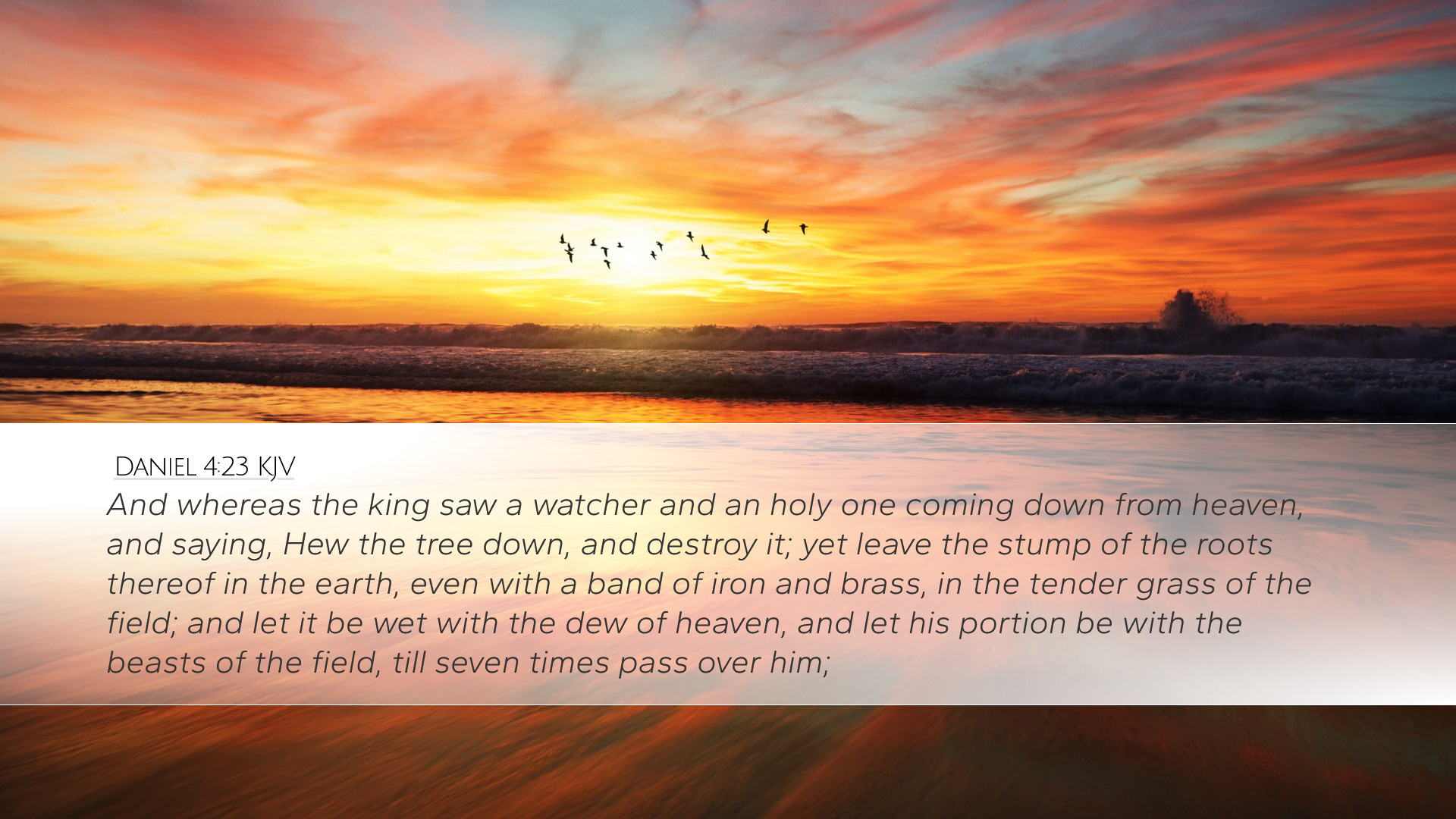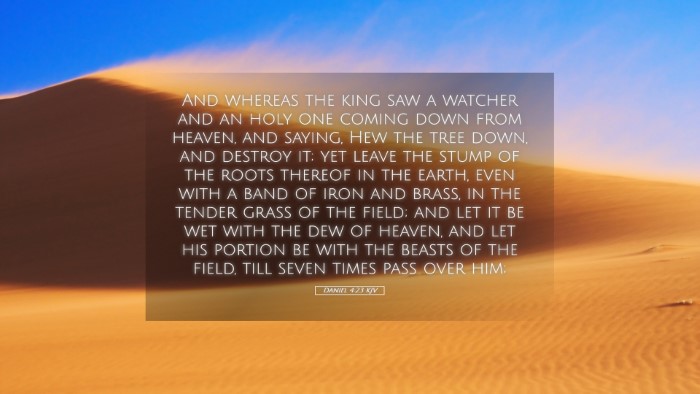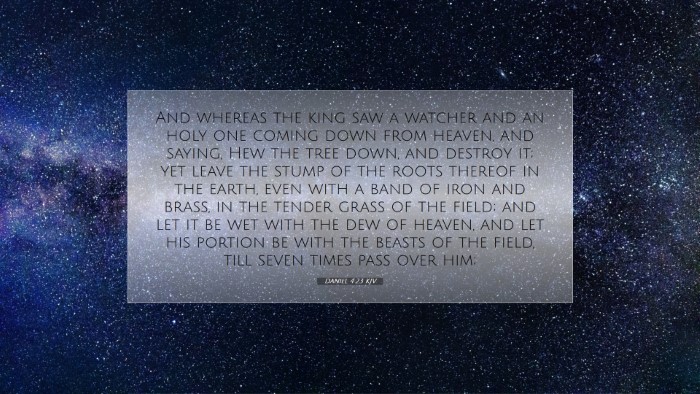Commentary on Daniel 4:23
Verse: "And whereas the king saw a watcher and an holy one coming down from heaven, and saying, Cut down the tree, and destroy it; yet leave the stump of the roots thereof in the earth, even with a band of iron and brass, in the tender grass of the field; and let it be wet with the dew of heaven, and let his portion be with the beasts in the grass of the earth."
Introduction
This verse is pivotal in the narrative of Nebuchadnezzar's dream, which serves as a divine warning about the king's pride and impending judgment. The interplay between sovereignty and humility is demonstrated vividly here as we interpret the implications of the divine decree conveyed through the watcher. Various theological commentaries provide an enriching tapestry of insights into this passage, which can aid pastors, students, and scholars in delving deeper into its meaning.
Contextual Analysis
This verse occurs at a crucial moment in the narrative of Daniel chapter 4, where King Nebuchadnezzar experiences a dream that troubled him greatly. The "watcher" and "holy one" symbolize a divine emissary, one of the heavenly hosts who executes God's will. The decree to ‘cut down the tree’ represents a significant act of judgment, signifying the humiliation of Nebuchadnezzar due to his pride.
Matthew Henry's Insights
Henry emphasizes the role of divine authority in the matters of earthly rulers. He posits that the “watcher” signifies a heavenly sentinel whose purpose is to observe and enact God’s judgment. This celestial being not only delivers God’s message but does so with a clear mandate: to cut down the tree, a metaphor for the king's powerful reign due to his hubris. The terminology used signifies the inevitable downfall that pride brings forth.
Albert Barnes' Interpretation
Barnes provides a detailed exegesis of the imagery of the tree, suggesting that it represents Nebuchadnezzar’s expansive kingdom, flourishing in prosperity and power. However, the command to leave the stump suggests a future restoration; though judgment is pronounced, God’s mercy is still evident. Barnes notes that the cutting down indicates not total destruction but a pause for reflection and repentance—an opportunity for the king to acknowledge the sovereignty of God.
Adam Clarke's Contributions
Clarke offers a nuanced understanding of the symbolism of the stump, asserting that it indicates a remnant of what was once great. The "band of iron and brass" suggests a preservation of the roots to signify a future, albeit humbled, restoration. He elaborates on the importance of the “dew of heaven,” linking it to blessings from God that Nebuchadnezzar, in his pride, seemed to overlook. Clarke underlines that even in judgment, God’s purpose is to bring individuals back to a place of humility and recognition of divine sovereignty.
Theological Implications
This verse conveys several theological themes relevant to pastors and theologians alike:
- Divine Sovereignty: The act of sending a watcher from heaven emphasizes that God is above all earthly powers. Kings, rulers, and authorities are ultimately under His divine command.
- The Nature of Judgment: The severity of the pronouncement serves as a reminder of the consequences of pride. God’s judgments can be both a disciplinary act and a pathway to restoration.
- Hope in Humility: The mention of leaving the stump symbolizes God’s grace. Even in the midst of judgment, there remains hope for renewal and restoration, reflecting God’s characteristic mercy.
Practical Applications
For contemporary readers, particularly those in pastoral roles or theological study, Daniel 4:23 has profound applications:
- Humility Before God: This passage encourages leaders to cultivate humility, recognizing the temporary nature of earthly power in contrast to God's eternal sovereignty.
- Recognition of Divine Intervention: It prompts believers to remain cognizant of God’s continuous watch over the affairs of men and the adjustments He might impose for correction and growth.
- Encouragement in Trials: For those facing judgment or consequences of their actions, this passage illustrates that there remains an opportunity for restoration and that God can bring good out of difficult circumstances.
Conclusion
Daniel 4:23 serves as a significant reminder that pride goes before a fall, but it also beautifully encapsulates the heart of God—seeking not just judgment, but ultimately restoration. The insights provided by Matthew Henry, Albert Barnes, and Adam Clarke offer a rich foundation for understanding these dynamics, serving as a vital source for reflection and application in our spiritual journeys. As we approach our roles as leaders and followers of Christ, let us take heed to the lessons learned from Nebuchadnezzar’s encounter with the divine.


